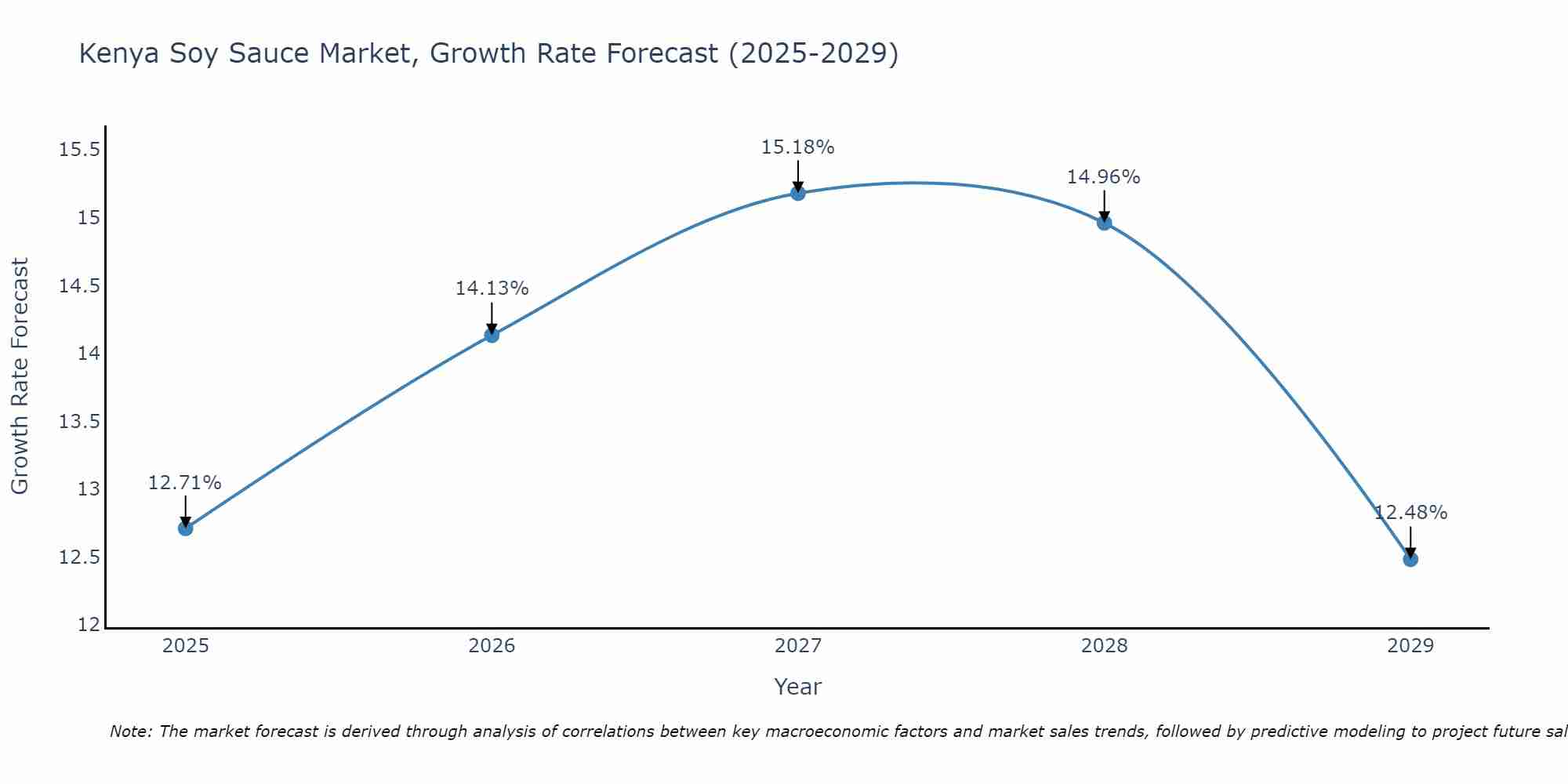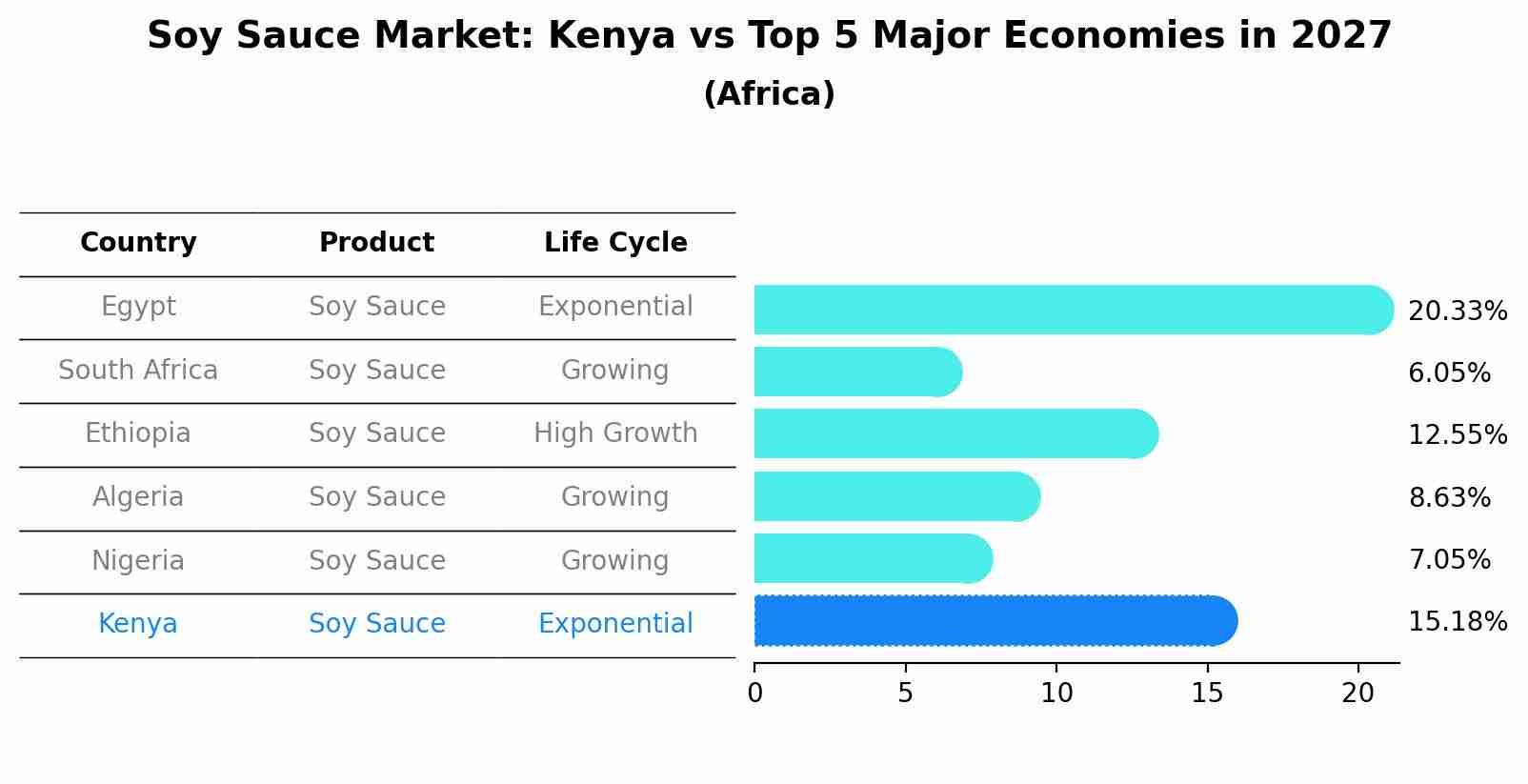Kenya Soy Sauce Market Outlook | Size, Analysis, Forecast, COVID-19 IMPACT, Industry, Value, Trends, Revenue, Growth, Share & Companies
| Product Code: ETC073689 | Publication Date: Jun 2021 | Updated Date: Jun 2025 | Product Type: Report | |
| Publisher: 6Wresearch | Author: Summon Dutta | No. of Pages: 70 | No. of Figures: 35 | No. of Tables: 5 |
Kenya Soy Sauce Market Size Growth Rate
The Kenya Soy Sauce Market is projected to witness mixed growth rate patterns during 2025 to 2029. The growth rate begins at 12.71% in 2025, climbs to a high of 15.18% in 2027, and moderates to 12.48% by 2029.

Soy Sauce Market: Kenya vs Top 5 Major Economies in 2027 (Africa)
By 2027, the Soy Sauce market in Kenya is anticipated to reach a growth rate of 15.18%, as part of an increasingly competitive Africa region, where Egypt remains at the forefront, supported by South Africa, Ethiopia, Algeria and Nigeria, driving innovations and market adoption across sectors.

Kenya Soy Sauce Market Overview
The Kenya Soy Sauce Market is witnessing steady growth driven by increasing consumer preference for Asian cuisine, growing awareness of the health benefits of soy sauce, and the expanding foodservice industry in the country. Local and international brands are competing in the market, offering a variety of soy sauce products to cater to the diverse culinary preferences of Kenyan consumers. The market is characterized by a mix of traditional soy sauce products and newer, innovative variants, such as low-sodium and organic options, to meet the changing consumer demand for healthier and high-quality condiments. Key players are focusing on product innovation, marketing strategies, and distribution channels to gain a competitive edge in the market and capitalize on the growing demand for soy sauce in Kenya.
Kenya Soy Sauce Market Trends
The Kenya soy sauce market is experiencing a shift towards healthier and more diverse options, with increasing demand for low-sodium, organic, and gluten-free soy sauces. Consumers are becoming more health-conscious and are looking for products with clean labels and natural ingredients. There is also a growing interest in ethnic cuisines and fusion cooking, driving the demand for specialty soy sauces such as tamari and teriyaki. Additionally, the market is seeing a rise in innovative packaging formats and convenient, on-the-go options to cater to busy lifestyles. Local producers are focusing on enhancing product quality and introducing unique flavor profiles to differentiate themselves in the competitive market. Overall, the Kenya soy sauce market is witnessing a trend towards healthier, more diverse, and convenient offerings to meet the evolving preferences of consumers.
Kenya Soy Sauce Market Challenges
In the Kenya Soy Sauce Market, some of the key challenges faced include competition from other condiment products, consumer preference for traditional cooking methods and flavors, limited awareness and understanding of soy sauce among the general population, and the high cost of imported soy sauce brands. Additionally, there may be issues related to distribution networks, quality control, and the availability of locally produced soy sauce options. Overcoming these challenges would require targeted marketing efforts to educate consumers about the benefits and versatility of soy sauce, developing affordable and high-quality domestic soy sauce brands, and strengthening distribution channels to reach a wider audience effectively.
Kenya Soy Sauce Market Investment Opportunities
The Kenya Soy Sauce Market presents promising investment opportunities due to the increasing consumer demand for diverse and international food products. With a growing interest in Asian cuisine and flavors, there is a rising trend in the consumption of soy sauce in Kenya. Investors can capitalize on this trend by exploring opportunities in soy sauce production, distribution, and marketing. Additionally, there is potential for innovation in the market by introducing new flavors, organic options, or convenient packaging formats to cater to the evolving preferences of Kenyan consumers. Collaborating with local restaurants, supermarkets, and food delivery services can also help in expanding market reach and driving sales. Overall, investing in the Kenya Soy Sauce Market offers a chance to tap into a growing segment of the food industry with untapped potential.
Kenya Soy Sauce Market Government Policy
In Kenya, the government has implemented policies to regulate food safety standards, including those related to soy sauce production. The Kenya Bureau of Standards (KEBS) sets guidelines for the quality and safety of soy sauce, ensuring that products meet specified standards before entering the market. Additionally, the government has put in place import regulations to control the entry of substandard or counterfeit soy sauce products, protecting consumers from potential health risks. These policies promote fair competition among soy sauce producers and help maintain consumer confidence in the market. Overall, the government`s focus on ensuring quality and safety in the soy sauce industry plays a crucial role in safeguarding public health and supporting the growth of the market in Kenya.
Kenya Soy Sauce Market Future Outlook
The future outlook for the Kenya Soy Sauce Market appears promising, driven by factors such as increasing consumer awareness about the health benefits of soy-based products, changing dietary preferences towards Asian cuisine, and a growing trend towards healthier eating habits. The market is expected to witness steady growth due to the rising demand for natural and flavorful condiments in cooking. Furthermore, the expanding foodservice industry and the increasing popularity of international cuisines among Kenyan consumers are likely to boost the consumption of soy sauce in the country. With manufacturers focusing on product innovation, packaging design, and marketing strategies to cater to evolving consumer preferences, the Kenya Soy Sauce Market is poised for sustained growth in the coming years.
Key Highlights of the Report:
- Kenya Soy Sauce Market Outlook
- Market Size of Kenya Soy Sauce Market, 2021
- Forecast of Kenya Soy Sauce Market, 2027
- Historical Data and Forecast of Kenya Soy Sauce Revenues & Volume for the Period 2018 - 2027
- Kenya Soy Sauce Market Trend Evolution
- Kenya Soy Sauce Market Drivers and Challenges
- Kenya Soy Sauce Price Trends
- Kenya Soy Sauce Porter's Five Forces
- Kenya Soy Sauce Industry Life Cycle
- Historical Data and Forecast of Kenya Soy Sauce Market Revenues & Volume By Product Type for the Period 2018 - 2027
- Historical Data and Forecast of Kenya Soy Sauce Market Revenues & Volume By Brewed for the Period 2018 - 2027
- Historical Data and Forecast of Kenya Soy Sauce Market Revenues & Volume By Blended for the Period 2018 - 2027
- Historical Data and Forecast of Kenya Soy Sauce Market Revenues & Volume By Application for the Period 2018 - 2027
- Historical Data and Forecast of Kenya Soy Sauce Market Revenues & Volume By Household for the Period 2018 - 2027
- Historical Data and Forecast of Kenya Soy Sauce Market Revenues & Volume By Food Industry for the Period 2018 - 2027
- Kenya Soy Sauce Import Export Trade Statistics
- Market Opportunity Assessment By Product Type
- Market Opportunity Assessment By Application
- Kenya Soy Sauce Top Companies Market Share
- Kenya Soy Sauce Competitive Benchmarking By Technical and Operational Parameters
- Kenya Soy Sauce Company Profiles
- Kenya Soy Sauce Key Strategic Recommendations
Frequently Asked Questions About the Market Study (FAQs):
1 Executive Summary |
2 Introduction |
2.1 Key Highlights of the Report |
2.2 Report Description |
2.3 Market Scope & Segmentation |
2.4 Research Methodology |
2.5 Assumptions |
3 Kenya Soy Sauce Market Overview |
3.1 Kenya Country Macro Economic Indicators |
3.2 Kenya Soy Sauce Market Revenues & Volume, 2021 & 2027F |
3.3 Kenya Soy Sauce Market - Industry Life Cycle |
3.4 Kenya Soy Sauce Market - Porter's Five Forces |
3.5 Kenya Soy Sauce Market Revenues & Volume Share, By Product Type, 2021 & 2027F |
3.6 Kenya Soy Sauce Market Revenues & Volume Share, By Application, 2021 & 2027F |
4 Kenya Soy Sauce Market Dynamics |
4.1 Impact Analysis |
4.2 Market Drivers |
4.3 Market Restraints |
5 Kenya Soy Sauce Market Trends |
6 Kenya Soy Sauce Market, By Types |
6.1 Kenya Soy Sauce Market, By Product Type |
6.1.1 Overview and Analysis |
6.1.2 Kenya Soy Sauce Market Revenues & Volume, By Product Type, 2018 - 2027F |
6.1.3 Kenya Soy Sauce Market Revenues & Volume, By Brewed, 2018 - 2027F |
6.1.4 Kenya Soy Sauce Market Revenues & Volume, By Blended, 2018 - 2027F |
6.2 Kenya Soy Sauce Market, By Application |
6.2.1 Overview and Analysis |
6.2.2 Kenya Soy Sauce Market Revenues & Volume, By Household, 2018 - 2027F |
6.2.3 Kenya Soy Sauce Market Revenues & Volume, By Food Industry, 2018 - 2027F |
7 Kenya Soy Sauce Market Import-Export Trade Statistics |
7.1 Kenya Soy Sauce Market Export to Major Countries |
7.2 Kenya Soy Sauce Market Imports from Major Countries |
8 Kenya Soy Sauce Market Key Performance Indicators |
9 Kenya Soy Sauce Market - Opportunity Assessment |
9.1 Kenya Soy Sauce Market Opportunity Assessment, By Product Type, 2021 & 2027F |
9.2 Kenya Soy Sauce Market Opportunity Assessment, By Application, 2021 & 2027F |
10 Kenya Soy Sauce Market - Competitive Landscape |
10.1 Kenya Soy Sauce Market Revenue Share, By Companies, 2021 |
10.2 Kenya Soy Sauce Market Competitive Benchmarking, By Operating and Technical Parameters |
11 Company Profiles |
12 Recommendations |
13 Disclaimer |
- Single User License$ 1,995
- Department License$ 2,400
- Site License$ 3,120
- Global License$ 3,795
Search
Thought Leadership and Analyst Meet
Our Clients
Related Reports
- Canada Oil and Gas Market (2026-2032) | Share, Segmentation, Value, Industry, Trends, Forecast, Analysis, Size & Revenue, Growth, Competitive Landscape, Outlook, Companies
- Germany Breakfast Food Market (2026-2032) | Industry, Share, Growth, Size, Companies, Value, Analysis, Revenue, Trends, Forecast & Outlook
- Australia Briquette Market (2025-2031) | Growth, Size, Revenue, Forecast, Analysis, Trends, Value, Share, Industry & Companies
- Vietnam System Integrator Market (2025-2031) | Size, Companies, Analysis, Industry, Value, Forecast, Growth, Trends, Revenue & Share
- ASEAN and Thailand Brain Health Supplements Market (2025-2031) | Strategy, Consumer Insights, Analysis, Investment Trends, Opportunities, Growth, Size, Share, Industry, Revenue, Segments, Value, Segmentation, Supply, Forecast, Restraints, Outlook, Competition, Drivers, Trends, Demand, Pricing Analysis, Competitive, Strategic Insights, Companies, Challenges
- ASEAN Bearings Market (2025-2031) | Strategy, Consumer Insights, Analysis, Investment Trends, Opportunities, Growth, Size, Share, Industry, Revenue, Segments, Value, Segmentation, Supply, Forecast, Restraints, Outlook, Competition, Drivers, Trends, Demand, Pricing Analysis, Competitive, Strategic Insights, Companies, Challenges
- Europe Flooring Market (2025-2031) | Outlook, Share, Industry, Trends, Forecast, Companies, Revenue, Size, Analysis, Growth & Value
- Saudi Arabia Manlift Market (2025-2031) | Outlook, Size, Growth, Trends, Companies, Industry, Revenue, Value, Share, Forecast & Analysis
- Uganda Excavator, Crane, and Wheel Loaders Market (2025-2031) | Strategy, Consumer Insights, Analysis, Investment Trends, Opportunities, Growth, Size, Share, Industry, Revenue, Segments, Value, Segmentation, Supply, Forecast, Restraints, Outlook, Competition, Drivers, Trends, Demand, Pricing Analysis, Competitive, Strategic Insights, Companies, Challenges
- Rwanda Excavator, Crane, and Wheel Loaders Market (2025-2031) | Strategy, Consumer Insights, Analysis, Investment Trends, Opportunities, Growth, Size, Share, Industry, Revenue, Segments, Value, Segmentation, Supply, Forecast, Restraints, Outlook, Competition, Drivers, Trends, Demand, Pricing Analysis, Competitive, Strategic Insights, Companies, Challenges
Industry Events and Analyst Meet
Whitepaper
- Middle East & Africa Commercial Security Market Click here to view more.
- Middle East & Africa Fire Safety Systems & Equipment Market Click here to view more.
- GCC Drone Market Click here to view more.
- Middle East Lighting Fixture Market Click here to view more.
- GCC Physical & Perimeter Security Market Click here to view more.
6WResearch In News
- Doha a strategic location for EV manufacturing hub: IPA Qatar
- Demand for luxury TVs surging in the GCC, says Samsung
- Empowering Growth: The Thriving Journey of Bangladesh’s Cable Industry
- Demand for luxury TVs surging in the GCC, says Samsung
- Video call with a traditional healer? Once unthinkable, it’s now common in South Africa
- Intelligent Buildings To Smooth GCC’s Path To Net Zero


















